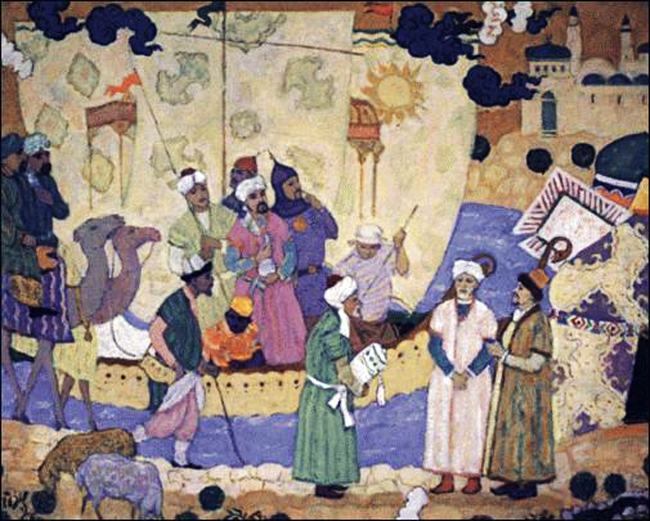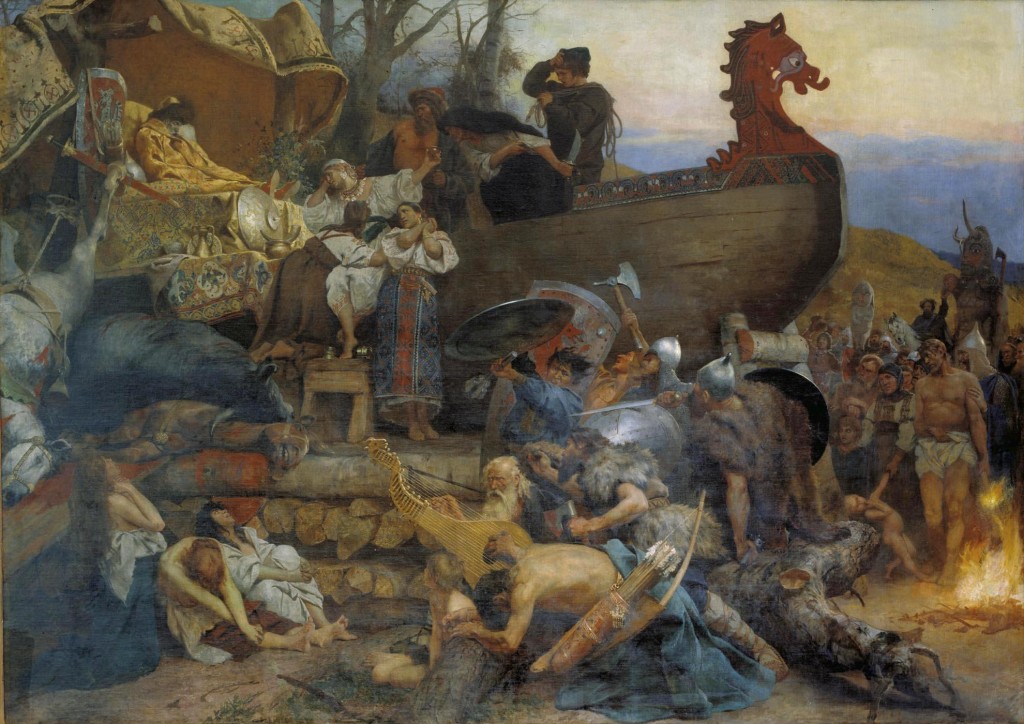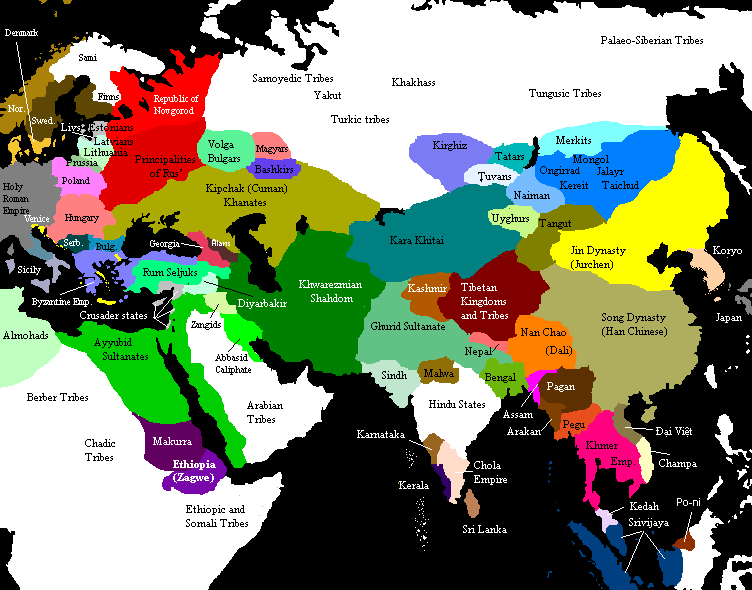by Islam El Shazly
Unlike his depiction in Michael Critchton’s Eaters of the Dead, or Antonio Banderas’ incarnation of him in The 13th Warrior, Ahmad ibn Fadlan was not expelled from the Court of the Abbasid Caliph because he courted one of the harems; he was actually favoured by the Caliph. His scholastic, literary, religious, and martial qualifications made him the primary candidate to lead a political and religious expedition. Its record would later be one of the earliest detailed descriptions of the Vikings.
Ahmad ibn Fadlan ibn Al-Abbas ibn Rashid ibn Hammad was a 10th century Muslim Arab writer and traveller who led an embassy to the king of the Volga Bulgars. His account is most known for providing a description of the Volga Vikings, including an eye-witness account of a ship burial.
Not much is known of him in terms of his life before the expedition, and much of his record was lost. What is known is that he was alive in the year 921 CE – 309 AH, and that he was allied to the Abbasid General Muhammad ibn Salman who led several military campaigns from Egypt to China.
Almış (Almas) iltäbär was the first Muslim ruler (emir) of Volga Bulgaria. Initially the vassal of the Khazars, he struggled against the Khazarian yoke and for unification of Bulgarian tribes and duchies. He sent a messenger to the Caliph Al-Muqtadir Billah in Baghdad with a letter asking for an embassy to teach the people religion (Islam) and financial assistance in building a mosque and a fortress to defend against the Khazar raids. His request was granted, and in 922 ambassadors of the Caliph set out on their journey led by Ibn Fadlan. Almas called himself Ja’afar ibn Abdullah after the Caliph’s name, and during his reign Volga Bulgaria finally developed to a united, strong and independent state.

Illustration of the expedition led by Ibn Fadlan to Northern Europe in a Russian museum in Narod, Russia.
The embassy left Baghdad on June 21, 921 (11 Safar 309 H). It reached the Bulgars after much hardship on May 12, 922 (12 Muharram 310 H). Until today, this day is an official religious holiday in modern Tatarstan. The journey took Ibn Fadhlan from Baghdad to Bukhara, to Khwarizm (south of the Aral Sea). Although promised safe passage by the Oghuz warlord, or Kudarkin, they were waylaid by Oghuz bandits but luckily were able to bribe their attackers. They spent the winter in Jurjaniya before travelling north across the Ural River until they reached the towns of the Bulgars at the three lakes of the Volga north of the Samara bend.
After arriving in Bulgar, Ahmad Ibn Fadlan made a trip to Wisu (modern Perm Krai of Russia) and recorded his observations of trade between the Volga Bulgars and local Finnic tribes.
A substantial part of Ibn Fadlan’s account is dedicated to the description of a people he called the Rūs or Rusiyyah. Most scholars identify them with the Rus’ or Varangians, which would make Ibn Fadlan’s account one of the earliest portrayals of Vikings.
The Rūs appear as traders that set up shop on the river banks nearby the Bulgar camp. They are described as having bodies tall as (date) palm-trees, with blond hair and ruddy skin. They are tattooed from “fingernails to neck” with dark blue or dark green “tree patterns” and other “figures” and that all men are armed with an axe and a long knife.

The ship burial of the Viking (Varangian) ruler Igor the Old in Kievan Rus', by Heinrich Semiradzki (1845-1902). State Historical Museum, Moscow.
Ibn Fadlan describes the Rus as having perfect bodies, with high cheekbones in the face. In contrast to their physical beauty, he describes the hygiene of the Rūsiyyah as disgusting (while also noting with some astonishment that they comb their hair every day) and considers them vulgar and unsophisticated. He also describes in great detail the funeral of one of their chieftains, a ship burial involving human sacrifice.
Ibn Fadlan’s expedition was not just an embassy; it had several other aspects assigned by the Caliph. In part it was a political/martial mission in that the expedition was meant to collect finances for building a fortress to protect the Volga Bulgars against the Jewish Khazar raids.
The other aspect was a religious mission, a mission that was requested by the King of the Bulgars to teach the principals, laws, and tenants of Islam to his people.
Ahmad ibn Fadlan was not a geographer, that explains the lack of geographical descriptions in his accounts and the lack of longitudes and latitudes, however, he did note the extreme length of night during the winter, and the length of daylight in the summer, a fact that made calculating prayer times very difficult.
The accounts of the expedition were written as a report to Al-Muqtadir. Concise, precise, and full of facts, but it’s more than that, it flows like a vivid story. His expedition authenticator said of him: “He doesn’t stray from an author’s style, and doesn’t come close to geographers’ traditions.” Source.
In his depiction in The 13th Warrior Hollywood as usual take creative liberties in order to make the hero more appealing to the western viewer. Critchton and the producers of the movie show Ahmad ibn Fadlan as a womanizer and lax in his religion to the point that when he is offered mead he refuses because “it’s not permissible to consume the fermentation of grapes”, when he is told it’s made from honey he readily accepts it!
Alcohol in all its incarnations is not permissible in Islam.
Ibn Fadlan was a pious man who carried the teachings of his religion wherever he went and behaved accordingly, nothing like his Hollywood counterpart.
For more about Ahmad ibn Fadlan please visit:
http://www.muslimheritage.com
http://en.wikipedia.org/wiki/Ahmad_ibn_Fadlan
http://www.alukah.net/Literature_Language/0/6567/#_ftn12 (Arabic)
And more about Viking funerals: http://en.wikipedia.org/wiki/Viking_funeral










Trackbacks for this post